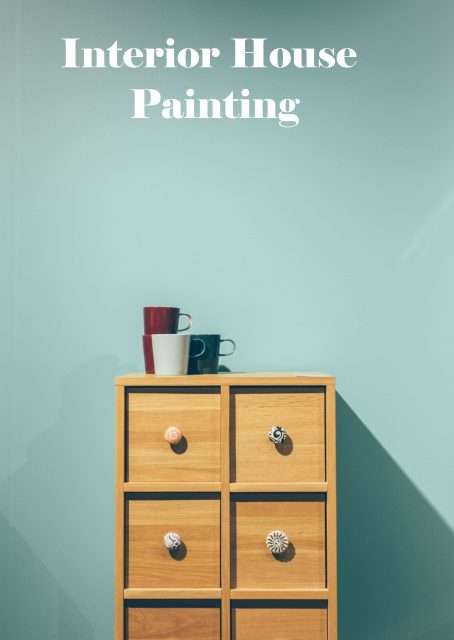Table of Contents
Introduction to Interior House Painting
Interior house painting is something of an art that can downright transform the ambience and aesthetic of your home. From beautiful wallpapers to intricate designs, designing and decorating your interior is hectic yet rewarding work. But it’s more than just applying paint to walls; it means careful planning, the right tools, and knowledge of techniques if you want a flawless finish.
Here’s why it’s helpful.
Benefits of Interior Painting
Refreshes and Revitalises Home’s Look
Interior painting can breathe new life into your home, reinvigorating it visually.
Creates Clean and New Spaces
A fresh coat of paint makes rooms feel clean and new, enhancing the overall ambience.
Enhances Mood and Productivity
The right colour scheme can considerably boost your mood and increase productivity.
Protects Walls from Damage
Painting protects the walls from the effects of water and moisture and prevents long-lasting damage.
Things You Must Know Before Painting Your Home Interior
Now that you know how beneficial interior painting is, it’s time to kickstart the process. Before you take a step towards house interior painting, make sure to prepare properly. Start by selecting the right type of paint for your walls. Consider factors like durability, finish, and ease of cleaning. Next, ensure your surfaces are clean and free from cracks or holes. You can opt for a professional painting service as well. Remember to plan your painting schedule, as certain conditions, like humidity, can affect the paint’s drying time.
Choose the Color
The first step in interior painting requires a brainstorming session. The most suitable shades according to the room surroundings and the shades of our choice don’t usually go hand in hand. So, choosing shades that satisfy both requirements takes time. Bold colors often enhance the house’s appearance in a better way.
Collect the Appropriate Components
You will need the following components to carry out the interior painting job:
Angled Brush
Squared Brush
Adjustable Extension Pole
Putty Knife
Ladder
Masking Tape
Drop Cloths
A Bucket Full of Water
Clean the Surface
Clean the interior walls and ceiling of dust or any other impurities. This helps the paint adhere better to the walls.
Prepare the Walls
Carefully inspect the walls for cracks, holes, and any imperfect surfaces. Use spackling paste to fill the holes and gaps. A putty knife can remove the excess paste, and then you can sand it to make it level with the surface after it dries.
Cover Other Surfaces
Covering other surfaces like floors, furniture, and windows is crucial. Use canvas drop cloths on the floor as they prevent slipping and are a good long-term investment.
Primer
Previously painted walls don’t necessarily need a primer. You just need to spot prime areas that need it. Priming is essential for unpainted walls as it removes stains, prevents moisture damage, and improves adhesion of the paint.
Putty
Applying putty is necessary for an interior house painting job. It removes the unevenness of the surface, small hairline cracks, and pores. Putty levels the surface from top to bottom and enhances the paint’s durability.
Paint
After completing the above steps, you can start the actual painting job. The painting should be done from top to bottom: start with the ceiling, then the walls, and then the remaining areas like doors, windows, and edges. Allow the previously painted surface to dry before moving on to the next. Keep the doors and windows open to help the paint dry faster. Once the paint is completely dry, remove the drop cloths, move in the furniture, arrange the space as you like, and admire your work.
Different Types of House Paint for Home Interiors
You can go for several types of paint for the interior painting of a house. Latex paint is popular due to its easy cleanup and durability. Oil-based paint, though less common, offers a smooth finish and is great for high-traffic areas. There are also specific paints like satin, eggshell, and matte. They offer different sheens and textures to suit any of your preferences.
Common Interior Painting Mistakes to Avoid
Avoiding common mistakes can save you time and frustration. First, don’t skip the primer! Skipping primer can lead to uneven colour and poor adhesion. Overloading the brush or roller can also cause drips and streaks. Not allowing enough drying time between coats can result in a tacky finish. Lastly, don’t neglect proper ventilation; this can lead to longer drying times and strong paint odours.
DIY vs. Hiring Professionals for Interior Painting
Want to do it by yourself? Or are you thinking of opting for professionals for house interior painting? This totally depends on your skills and time availability. DIY can be cost-effective and rewarding if you have the necessary tools and design in mind. However, professional painters bring expertise, efficiency, and high-quality results, which can be worth the investment, especially for larger projects or intricate designs. Also, you don’t have to worry about post-work touch ups or cleaning with professional services.
Summary
Interior house painting is a rewarding and fun task; it’s one way to enhance your home’s look and market value. Whether you’re doing it on your own or deciding to go with professionals, there are some essential steps involved so that your home showcases real beauty and responds to your personality. Start with proper preparation, including cleaning off your walls with an appropriate primer for a silky finish. High-quality paint and excellent tools make a lot of difference as well. Choosing the correct colours also enhances the potential of your decor. So, don’t forget to take your time and enjoy the progress in making a beautiful transformation that you will love.
[otw_shortcode_button href=”https://aapkapainter.com/painters-in-bangalore” size=”medium” bgcolor=”#e03f57″ icon_position=”left” shape=”round”]Book Painting Service in Bangalore[/otw_shortcode_button]
